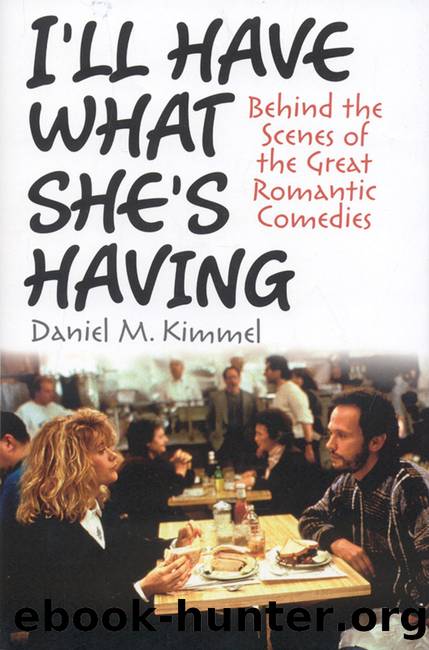I'll Have What She's Having by Daniel M. Kimmel

Author:Daniel M. Kimmel
Language: eng
Format: epub
ISBN: 9781615780327
Publisher: Ivan R. Dee
INTERMISSION
HAVING SELECTED three representative films from the 1930s, the 1940s, and the 1950s, we now leap over most of the next two decades to pick up the trail with Annie Hall, released in 1977. What happened to the romantic comedy in between? Film genres go in and out of fashion, of course. But one of the arguments here is that romantic comedies reflect the times in which they were made, and that helps explain what happened during this gap.
In a nutshell, the problem was that the filmmakers and performers who were adept at romantic comedy were dying, retiring, or moving on to other things, while a new generation had little interest in an âold-fashionedâ form. Remember, Pillow Talk in 1959 was thought to revive a supposedly dead kind of movie. Consider just a few of the performers.
Following Some Like It Hot, Marilyn Monroe worked on only three more films. Letâs Make Love (1960) was a mild success with Monroe as an entertainer in a show spoofing the wealthy character played by Yves Montand. Monroe continued being difficult on the set, and even the veteran director George Cukor couldnât control her. She went on to do the dramatic The Misfits with Clark Gable and the director John Huston, and then worked with Cukor again on Somethingâs Got to Give. This last film was never finished, and Monroe was deadâa suicideâin August 1962.
Cary Grant appeared in numerous romantic comedies, and audiences loved him no matter how old he grew. But he made only five films in the 1960s, and you could tell that he was getting tired of romantic comedy. The Grass Is Greener (1960) and That Touch of Mink (1962) were pale shadows of his glory days, even though he was paired with Deborah Kerr in the former and Doris Day in the latter. Charade (1962) is easily the best of the bunch, but though thereâs a bit of romantic comedy there with Grant and Audrey Hepburn, it takes a back seat to the main story, a Hitchcock-like thriller. It says something about Grantâs attitude that he insisted the script indicate that Reggie, the young widow played by Hepburn who was many years Grantâs junior, should be seen as pursuing him, rather than the other way around. Romance similarly took a back seat in the plot of Father Goose (1964), and in his final film, Walk Donât Run (1966), Grant isnât even the romantic lead. Heâs the man playing Cupid to bring Samantha Eggar and Jim Hutton together.
Audrey Hepburn also was headed toward retirement. She made nine films in the 1960s, then left the screen to focus on her family, not returning until Richard Lesterâs touching Robin and Marian (1976), about the latter days of Robin Hood, with Sean Connery as Robin and Hepburn as Maid Marian. Of her sixties films, the romantic comedies are inevitably about something else, or else turn into comedy-dramas. Her iconic performance in Breakfast at Tiffanyâs (1961) has its comic moments but is really a bittersweet story about two broken people who need to grow up.
Download
This site does not store any files on its server. We only index and link to content provided by other sites. Please contact the content providers to delete copyright contents if any and email us, we'll remove relevant links or contents immediately.
The Kite Runner by Khaled Hosseini(4473)
Gerald's Game by Stephen King(3928)
The Perils of Being Moderately Famous by Soha Ali Khan(3791)
Dialogue by Robert McKee(3593)
Story: Substance, Structure, Style and the Principles of Screenwriting by Robert McKee(2992)
The 101 Dalmatians by Dodie Smith(2942)
The Pixar Touch by David A. Price(2744)
Confessions of a Video Vixen by Karrine Steffans(2681)
Fantastic Beasts: The Crimes of Grindelwald by J. K. Rowling(2550)
How Music Works by David Byrne(2536)
Slugfest by Reed Tucker(2424)
Harry Potter 4 - Harry Potter and The Goblet of Fire by J.K.Rowling(2420)
The Mental Game of Writing: How to Overcome Obstacles, Stay Creative and Productive, and Free Your Mind for Success by James Scott Bell(2398)
Wildflower by Drew Barrymore(2121)
Scandals of Classic Hollywood: Sex, Deviance, and Drama from the Golden Age of American Cinema by Anne Helen Petersen(2115)
Casting Might-Have-Beens: A Film by Film Directory of Actors Considered for Roles Given to Others by Mell Eila(2077)
Screenplay: The Foundations of Screenwriting by Syd Field(2064)
Robin by Dave Itzkoff(2010)
The Complete H. P. Lovecraft Reader by H.P. Lovecraft(1978)
